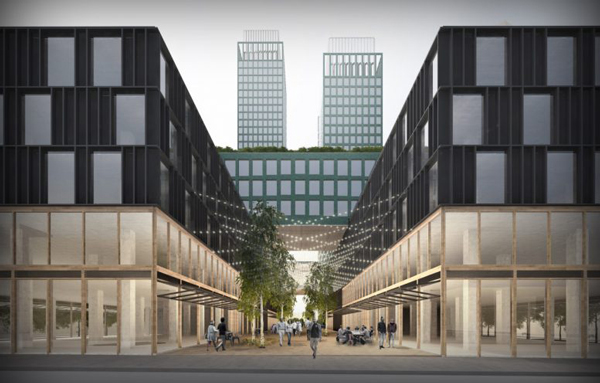
Both tears and applause made appearances at the well-attended quarterly North Brooklyn Development Meeting last Thursday, February 28th, where citizens voiced frustrations about elected officials’ perceived lack of action and concerns about public health conditions. The lengthy two and a half hour-long meeting featured presentations from representatives for Nuhart Plastics Plant, New York State Department of Environmental Conservation (DEC), Brookfield Development, Red Sky Capital, James Corner Field Operations, New York City Office of Environmental Remediation, and New York City Department of Mental Health and Hygiene (DMMH). Heated Q&As involving nearly 50 attendees followed each presentation.
The first agenda item was an update regarding the proposed school development site at Nuhart Plastics Plant. According to Mosa Moore, the Government Relations representative for Nuhart, the two current partners/owners have been in a lawsuit that had brought the process to a standstill. He noted, “The judge just dismissed the case as of February 20th, so I believe they will be moving forward.”
Contamination from the sidewalk down for the Nuhart site is handled by the DEC, represented at the meeting by Jane O’Connell. O’Connell explained that monitoring operates under the Imposed Remedial Action Plan. The first component is a Feasibility Study, which considers six criteria set by Federal Law: cost, effectiveness, implementation, long-term effects, short-term effects, and impact on the community. Following the study, there is a 30-day (extended to 60-day for this situation due to the public response) public comment period. The DEC must address all comments in a Responsiveness Summary, and then will issue a Record of Decision, a final “bare bones” document on site contamination. O’Connell noted that “this is on schedule to come before the end of March.”

A primary concern in response to O’Connell’s presentation was the upholding of the DEC’s standards and ability to ensure effective monitoring at all times and amongst multiple involved parties. Who is responsible for monitoring on the weekends? Who insures that utility companies do not interact with the toxic waste when they address pipelines a couple of feet underground? O’Connell clarified that the Department of Buildings establishes work hours and guidelines for safe working conditions, and that the DEC would comply.
Concern about Nuhart illuminated general unease about pollution in the broader Greenpoint area, both underground and airborne. Zach Schriver of the Office of Environmental Remediation, a group of 15 engineers and scientists, provided information on a new website that will make work on projects like Nuhart more transparent for the community. The website is the Environmental Project Information Center (EPIC), and provides work updates and historical records on a user-friendly online portal.
A tool for air quality monitoring is the publicly-available data collected in the New York City Community Air Survey, conducted by the Department of Mental Health and Hygiene. The study takes place during a designated period each season, collecting one air sample every two weeks from 75 locations throughout the city. Locations represent a wide variety of urban environments, from traffic-congested midtown streets to suburban areas in Queens. The purpose is to collect data on pollution caused by fossil fuels (which are used by trucks, broilers, heating systems in large buildings, etc.).The data is shared through an annual report released on Earth Day. Level of pollutants city-wide has been steadily decreasing over the past decade, but the question lingers: why has the neighborhood of Greenpoint been improving at a significantly slower rate? Meeting attendees seemed skeptical of elected officials’ willingness to take this data seriously enough to take action.
There were also questions about the intentions of developer Brookfield, currently developing two major residential complexes along Greenpoint’s waterfront. Dan Berger, representing Brookfield, builders of 1 Blue Slip, a 30-story tower and 2 Blue Slip, a 40-story tower, explained that the total 10-building project will create about 5600 apartments, with potential to bring in 14,000 new residents. The immediate concern is that this influx will exacerbate an already congested area. But there were also aesthetic concerns. One attendee asked, “would you consider taking into account the existing architectural details of the neighborhood, perhaps building something a little shorter?” Another attendee asked, “Would you consider including something like a green space that would benefit the community as a whole?” Berger responded by saying the way to get answers or results was to make complaints to the Parks and Recreation Department, who establishes regulations and guidelines for construction.

The second developer at the meeting was Red Sky, who brought in partner landscape architecture firm Field Ops to present on their waterfront complex at 18 India Street. The presentation demonstrated a clear consideration of the unique landscape and ethos of its boating dock location. Karen Tamir from Field Ops explained that the “slips inform the site plan” and that the design aims to capture the “idea of love of boating.” Other details included a public garden leading down to water, lights and seating, a large open gathering area on the southern side of the site, a lawn, and countertop with stools overlooking the river. “The River comes to life and becomes apart of the scenery and experience,” Samir explained. Ben Stokes of Red Sky added that the developer is fighting to maintain control, rather than turning the site over to the oversight of the Parks department, making it a privately controlled public space. His statement was met with applause.

The concept of privately owned public space can mean that developers genuinely concerned with good design and quality of life have the freedom to look out for the community. But private property rights can also cause issues when property owners refuse to allow monitoring organizations like the DEC and OER to complete testing, in order to ensure that the properties are free of chemical contamination. A resident implored the elected officials to look into changing the laws. “This isn’t something that should just stay the way it is. Real people are getting sick, and something needs to be done.”
*** This article was updated for accuracy on March 12, 2019.



